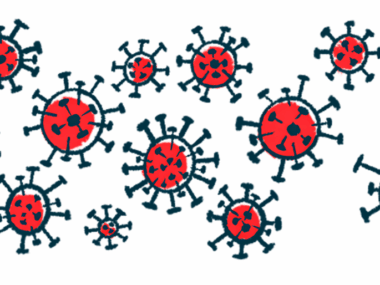#ACTRIMS2020 – Ofatumumab Self-injection Pen Equivalent to Prefilled Syringe, APLIOS Trial Shows
Written by |

Using a patient-friendly autoinjector pen to take monthly doses of ofatumumab — an investigational B-cell therapy for relapsing multiple sclerosis (MS) — is bioequivalent to delivering it via a prefilled syringe, and would allow self-administration of the treatment at home, a study shows.
Equal effects were found regardless of whether the ofatumumab was injected in the abdomen or the thigh. The results also showed similar body exposure to the therapy and sustained B-cell depletion with the pen as compared with the use of the prefilled syringe.
The findings were presented at the Americas Committee for Treatment and Research in Multiple Sclerosis (ACTRIMS) Forum 2020, held Feb. 27-29 in West Palm Beach, Fla. Amit Bar-Or, MD, of the Perelman School of Medicine at the University of Pennsylvania, presented the poster, titled “Onset Of B-cell Depletion With Subcutaneous Administration Of Ofatumumab In Relapsing Multiple Sclerosis: Results From The APLIOS Bioequivalence Study.”
Ofatumumab is a fully human, lab-made antibody co-developed by Genmab and Novartis. So far, it has been approved by the U.S. Food and Drug Administration (FDA) only for treating chronic lymphocytic leukemia, under the brand name Arzerra.
However, both the FDA and the European Medicines Agency (EMA) are now reviewing applications by Novartis seeking regulatory approval of ofatumumab for relapsing forms of MS in adults.
The agent specifically targets CD20, a marker present on B-cells and T-cells, which are immune cells that play a major role in MS development. Ofatumumab works by eliminating or depleting these cells in the blood and lymphoid tissues — structures that support immune responses, including the bone marrow, thymus, lymph nodes, and spleen. The therapy is expected to reduce inflammation in the central nervous system or CNS, composed of the brain and spinal cord.
The mechanism of action of ofatumumab is similar to that of Ocrevus (ocrelizumab), an approved MS therapy, and rituximab, a blood cancer treatment used off-label in MS. Both also target CD20.
But while Ocrevus and rituximab are delivered by into-the-vein (intravenous) infusions, ofatumumab would be delivered by once-per-month, under-the-skin (subcutaneous) injections. A key difference for patients is that ofatumumab can be self-administered at home instead of requiring a visit to a hospital or clinic.
In two Phase 3 clinical trials — ASCLEPIOS I (NCT02792218) and II (NCT02792231) — monthly injections of ofatumumab also were found to work better than daily treatment with Aubagio (teriflunomide) tablets in people with relapsing MS. Ofatumumab led to more clinically meaningful reductions than Aubagio, marketed by Sanofi Genzyme, in relapse rates and delayed disability progression. Indeed, treatment with ofatumumab induced a more than 50% decrease in relapse rates compared with Aubagio in MS patients — including those with relapsing-remitting MS (RRMS) and active secondary progressive MS (SPMS).
The trials — sponsored by Novartis — also showed that ofatumumab led to a more than 90% reduction in active brain lesions, reflecting a marked effect on inflammatory activity.
In both ASCLEPIOS trials, ofatumumab was administered via a prefilled syringe. However, researchers said the use of the autoinjector pen might ease self-administration at home, as pens are easier and more convenient to use.
Novartis recently completed an open-label Phase 2 trial evaluating whether ofatumumab (20 mg) delivery via an autoinjector pen — called SensoReady — was bioequivalent to an infusion using a prefilled syringe. The APLIOS study (NCT03560739) assessed whether the different measures would lead to similar blood concentrations of ofatumumab, and produce the same effects in the body.
The study compared the pharmacokinetics of the two delivery systems — how they affected the medication’s absorption, distribution, and metabolism in the body, and its excretion. It also examined ofatumumab’s effects on the number of B-cells in the bloodstream following its administration via a prefilled syringe or autoinjector, and at different injection sites, specifically in the abdomen versus the thigh.
A total of 284 adults with RRMS or active SPMS, ages 18 to 55, were randomly divided into four groups. Two groups had the therapy given via the abdomen, using either the autoinjector pen (128 patients) or a prefilled syringe (130 patients). For the other two groups, either the autoinjector pen (13 patients) or the prefilled syringe (13 patients) was used to administer the ofatumumab into the thigh.
The participants first received a “loading dose,” or an initial dose of ofatumumab on days 1, 7, and 14. From week 4 onward, they received the therapy every four weeks as a maintenance dose.
Blood samples were collected at the study’s start (baseline), and at eight points over the 12 weeks to assess the therapy’s pharmacokinetics and B-cell depletion. Samples were taken at day 1, day 4, day 7, day 14, week 4, week 6, week 8, and week 12.
The results showed that ofatumumab’s administration in the abdomen via the autoinjector pen was bioequivalent to infusion with a prefilled syringe, as determined by two pharmacokinetic measures. One measure was maximum plasma concentration (Cmax), while the other was area under the curve (AUCtau), which reflects the body exposure to the therapy.
Bioavailability — the degree and rate at which a medicine is absorbed or is made available — was similar between the abdomen and thigh injections, and across all treatment groups. The ofatumumab levels rose up through day 14, and stabilized after week 8 at concentrations superior to 1 μg/mL.
Regarding B-cell depletion, according to Bar-Or, the median B-cell counts were 214 cells/μL in the total study population at the start of the trial, and were significantly reduced by ofatumumab treatment.
The treatment “rapidly depleted B-cells, with median B-cell counts of 2 cells/μL by day 14, and sustained at 1 cell/μL [or less] up to day 84 [week 12],” the researchers said.
Approximately 85% of the patients achieved low B-cell counts (lower than 10 cells/µL) by day 14, while 94% achieved it by week 4. In nearly all patients (98.1%), B-cell depletion was maintained through week 12.
The safety profile was similar for all treatment groups, and consistent with what was known from the ASCLEPIOS trials. In total, 57% of the patients reported adverse events, most of which were mild-to-moderate in severity. Seven patients reported severe adverse events (2.5%).
Injection-related reactions were more common with the first injection, gradually decreasing in subsequent doses. Most were mild-to-moderate. Reactions with body-wide (systemic) effects predominantly occurred with the first injection (25%), and were most commonly headaches, chills, and fever.
No life-threatening effects or deaths were reported.
Overall, “bioequivalence was demonstrated between the prefilled syringe and Autoinjector pen, and the systemic exposure to ofatumumab was similar across the injection sites (abdomen or thigh),” the researchers said.
Regardless of injection device or site, monthly ofatumumab results in rapid and nearly complete B-cell depletion, and “offers an effective B-cell depleting therapy using the patient-friendly Autoinjector pen,” they concluded.
Based on the positive results of the ASCLEPIOS I and II trials, Novartis had sought FDA approval for the treatment in the U.S., and EMA approval for its use in the EU. Both Novartis’ supplemental Biologics License Application (sBLA) to the FDA, and its Marketing Authorization Application to the EMA were accepted in February. Final decisions are expected by June 2020 in the U.S., and by 2021 in Europe.
At ACTRIMS, Alexandra Goodyear, MD, medical director at Novartis, told Multiple Sclerosis News Today that these data are “part of our submission package to the FDA, so we are hopeful to be able to launch the drug [ofatumumab] with an autoinjector pen,” if approved.
Goodyear also emphasized that the results obtained in the APLIOS study confirm that the chosen 20 mg dose of ofatumumab was the right choice.
The data “nicely established that we’ve picked the right dose, and the right loading regimen, and that the monthly dosing is also correct, because there is no reconstitution of B-cells in between doses — they remain suppressed with monthly doses,” Goodyear said.





